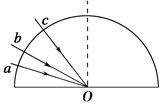问题
选择题
如图所示,半圆形玻璃砖放在空气中,三条同一颜色、强度相同的光线,均由空气射入玻璃砖,到达玻璃砖的圆心位置.下列说法正确的是( ).

A.假若三条光线中有一条在O点发生了全反射,那一定是aO光线
B.假若光线bO能发生全反射,那么光线cO一定能发生全反射
C.假若光线bO能发生全反射,那么光线aO一定能发生全反射
D.假若光线aO恰能发生全反射,则光线bO的反射光线比光线cO的反射光线的亮度大
答案
ACD
三条入射光线沿着指向圆心的方向由空气射向玻璃砖,在圆周界面,它们的入射角为零,均不会偏折.在直径界面,光线aO的入射角最大,光线cO的入射角最小,它们都是从光密介质射向光疏介质,都有发生全反射的可能.如果只有一条光线发生了全反射,那一定是aO光线,因为它的入射角最大,所以选项A对.假若光线bO能发生全反射,说明它的入射角等于或大于临界角,光线aO的入射角更大,所以,光线aO一定能发生全反射,光线cO的入射角可能大于临界角,也可能小于临界角,因此,cO不一定能发生全反射.所以选项C对、B错.假若光线aO恰能发生全反射,光线bO和cO都不能发生全反射,但bO的入射角更接近于临界角,所以,光线bO的反射光线较光线cO的反射光线强,即bO的反射光线亮度较大,所以D对,本题答案选A、C、D.
